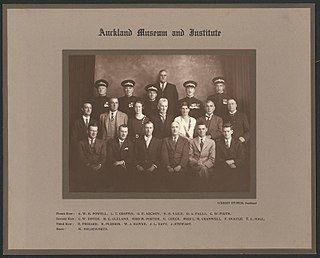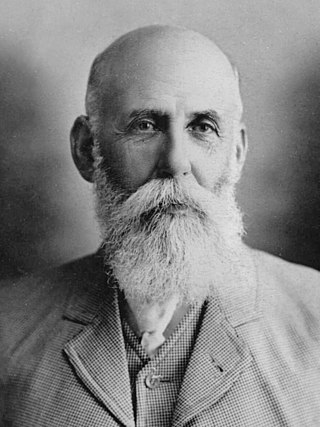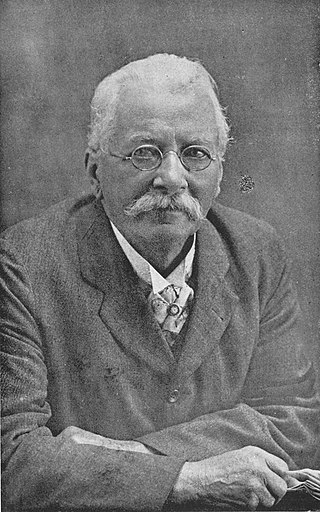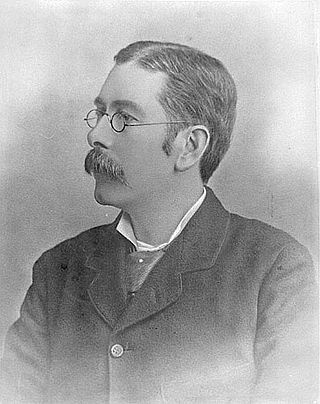
William Herbert Guthrie-Smith FRSNZ was a New Zealand farmer, author and conservationist.

Leonard Cockayne is regarded as New Zealand's greatest botanist and a founder of modern science in New Zealand.

The Royal Society of Victoria (RSV) is the oldest scientific society in Victoria, Australia.

The New Zealand Electronic Text Collection is a freely accessible online archive of New Zealand and Pacific Islands texts and heritage materials that are held by the Victoria University of Wellington Library. It was named the New Zealand Electronic Text Centre until October 2012.

Frederick Chapman was the inaugural Australian Commonwealth Palaeontologist.

Arthur William Baden Powell was a New Zealand malacologist, naturalist and palaeontologist, a major influence in the study and classification of New Zealand molluscs through much of the 20th century. He was known to his friends and family by his third name, "Baden".

Thomas Frederick Cheeseman was a New Zealand botanist. He was also a naturalist who had wide-ranging interests, such that he even described a few species of sea slugs.

Thomas Bannatyne Gillies was a 19th-century New Zealand lawyer, judge and politician.

Henry Suter was a Swiss-born New Zealand zoologist, naturalist, palaeontologist, and malacologist.

Thomas Jeffery Parker F.R.S. was a zoologist who worked in New Zealand.
The Botanical Society of Scotland (BSS) is the national learned society for botanists of Scotland. The Society's aims are to advance knowledge and appreciation of flowering and cryptogamic plants, algae and fungi. The Society's activities include lectures, symposia, field excursions, field projects and an annual Scottish Botanist's Conference, held jointly with the Botanical Society of Britain and Ireland for exchange of information between botanists working in different areas. Its publications include a twice-yearly newsletter, BSS News, and a scientific journal, Plant Ecology & Diversity. The society is closely linked to the Royal Botanic Garden Edinburgh and the Scottish universities.

John Buchanan was a New Zealand botanist and scientific artist. He was a fellow of the Linnean Society.

Thomas Broun was a Scottish-born soldier, farmer, teacher and entomologist, who spent much of his career in New Zealand. He is known for his study of the beetles (Coleoptera) of New Zealand.

Harry Howard Barton Allan was a New Zealand teacher, botanist, scientific administrator, and writer. Despite never receiving a formal education in botany, he became an eminent scientist, publishing over 100 scientific papers, three introductory handbooks on New Zealand plants, and completing the first volume of a flora in his lifetime.

Donald Petrie was a Scottish botanist noted for his work in New Zealand.

Thomas Wrench Naylor Beckett was an English-born coffee and tea planter in Ceylon and a noted botanist and bryologist, who collected specimens there and in the north-western Himalaya between 1882 and c.1900. He did not publish any account of the mosses he collected while in Ceylon – many of his specimens though are recorded in Max Fleischer's "Musci der Flora von Buitenzorg". He emigrated to New Zealand where he also collected. His main pteridophyte collection is at World Museum Liverpool. His bryophyte material at Kew was transferred to the British Museum of Natural History in about 1961 in terms of the Morton Agreement. The University of Canterbury and Christchurch houses some 12,000 of his specimens. Beckett was one of three amateur bryologists active in Christchurch, the other two being Robert Brown (1824–1906) and Thomas George Wright (1831–1914).

Epichorista emphanes, the beech leafroller, is a species of moth of the family Tortricidae. It is found in New Zealand.

The Geological Society of Glasgow is a scientific society devoted to the study of geology in Scotland.
James Stirton was a Scottish physician and one of Scotland's leading experts on cryptogamic botany. His investigations in bryology and lichenology earned him a world-wide reputation.

Susan Selina "Mimie" Wood was a New Zealand secretary, accountant, and librarian for the Royal Society of New Zealand. She was employed by the organisation from 1920 until her retirement in 1962. Coleridge Farr, president of the New Zealand Institute from 1929 to 1931, said of her that it would be more accurate to describe her as the institute's assistant president. She carried a large administrative load at the Royal Society and correctly predicted that upon her retirement, she would be replaced by five people; those five positions were established within three years of her departure.

















